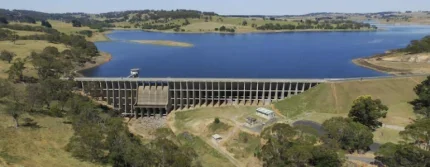
Specialist divers working in the icy waters of Lake Oberon in New South Wales, Australia, are nearing the completion of a project to replace valves in the Oberon Dam intake tower. This week, they are set to replace the last and deepest valve, located 30m underwater. Each valve weighs approximately 400 kilograms, and the divers are operating in confined spaces while wearing dry suits and large diving helmets.
“Bear in mind that each valve weighs about 400 kilograms, and only one diver can work at a time due to the tightly restricted space in the intake tower,” said Brian Mayhew, WaterNSW General Manager of Regional Operations Sydney.
The operation involves a diver descending by ladder into the intake tower and, in a confined space, undoing 12 large bolts to remove the old valve. The old valve is then lifted via a winch operated by a team above, who guide the new valve down for the diver to install by re-screwing the 12 bolts.
“It’s a highly specialised operation, and we take every safety precaution to keep our staff and contractors safe,” Mayhew added.
The maintenance project, which started last month and is expected to finish within the next fortnight, involves replacing a series of valves along the intake tower that control water release from the dam as part of WaterNSW’s Fish River supply scheme. This scheme provides water to Oberon and Lithgow councils, Mount Piper power station, and about 230 properties along its length, and supplements town supplies in the upper Blue Mountains.
“The water temperature has been a chilly eight degrees, but these specialist divers wear dry suits and do this kind of work year-round,” Mayhew said. “The work will help ensure the reliable and efficient operation of the Oberon Dam intake tower and safe water supply to customers in the Fish River region.”
Oberon Dam is located on the Fish River, about three kilometres south of Oberon on the NSW Central Tablelands, approximately 190 kilometres west of Sydney. At 1068m above sea level, Lake Oberon is classified as alpine waters.
“WaterNSW invests in regular maintenance and upkeep to ensure the reliability of our assets into the future and provide the best outcomes for our customers,” Mayhew noted.






